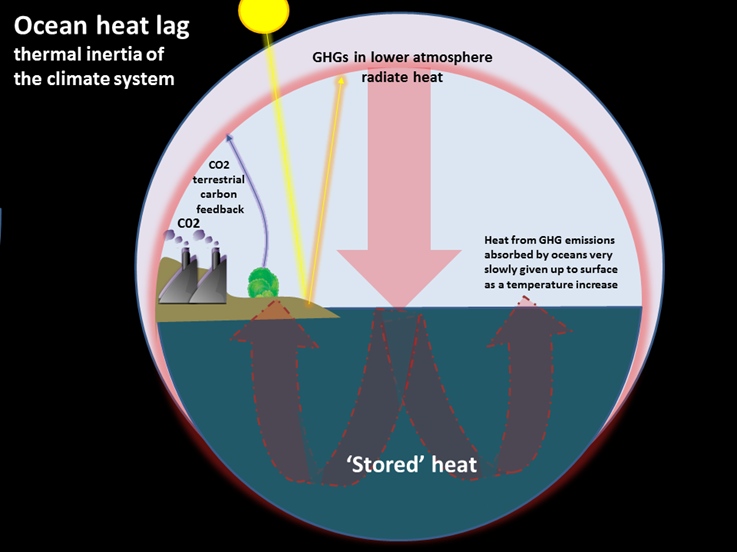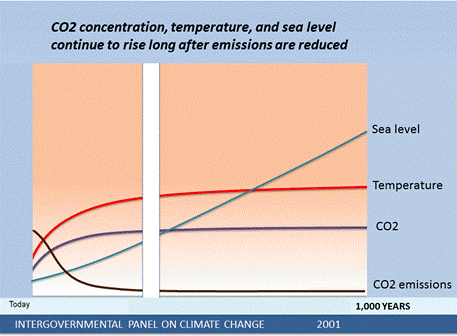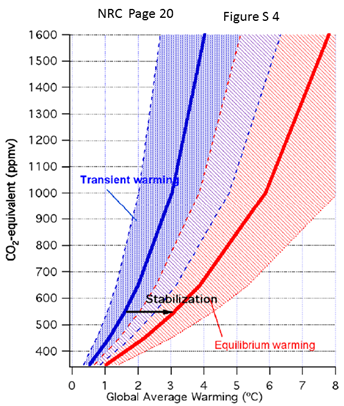Climate Change Commitment
Climate change commitment is the term used by scientists to convey the fact that there is a lot more warming we are locked into than today's warming.
It is fundamental to understanding our planetary state of emergency today.
Commitment is the result of system inertias or long lag times. The climate system is characterized by great inertia and great momentum under forcing.
Today's global average warming is 0.8C from pre-industrial. We are committed/locked in to several times today's warming.
There is no single definition of commitment.
The IPCC AR4 presents three definitions of commitment saying none them are the full 'unavoidable commitment'.
It is because of commitment that global warming and climate change impacts will be far greater than we are experiencing today (even with an emergency response) and will last thousands of years.
We present climate change commitment (at several international climate change conferences) as the total unavoidable warming estimated by a simple summation from all unavoidable sources of warming. This assumes a rapid mitigation response and no planetary cooling or extraction of CO2.
The scientists generally refer to commitment as limited to the climate thermal inertia of the ocean heat lag. The vast ocean water has absorbed over 90% of the heat from industrial age GHG emissions. The ocean water absorbs heat slowly and gives up heat to the planet's surface very slowly. I this sense the oceans store heat for a long time.
A complete list if unavoidable sources of warming
1. Today's warming
0.8C
2. Time taken to stabilize atmospheric greenhouse gases
(socio-economic-technological inertia). Clearly with no new measures on the world climate agenda till after 2020 and nothing planned, this is an inertia of decades, as is contemplated by the best case mitigation scenarios. To stabilize atmospheric CO2, industrial carbon emissions must stop (zero carbon). The best case IPCC scenario to zero carbon is 50 years. James Hansen puts the additional committed warming from this inertia at 0.6C. There is no published science on how fast we could get down to zero emissions. We take 0.4C assuming an emergency response, putting us at 1.2C (from our 0.8C start today).
2. Unmasking air pollution aerosol cooling deferred warming.
We all know burning fossil fuels produces air pollution that causes and contributes to a myriad of very costly health disorders. Black carbon (soot) particulates is a large contributor to global warming, but the aerosols are a much larger source of global cooling. Because these pollutant global emissions have to reduced for air quality and virtually stopped for climate change and ocean acidification mitigation, the hidden warming will be unmasked and the global temperature will rapidly rise. The amount of this cooling is estimated by the IPCC AR4 at 0.4C up to a possible 0.8C. We take 0.6C putting us at 1.8C.
(Ramanathan and Feng were published in PNAS 2008 pointing out that the prevailing science which does not account for this deferred warming is wrong and calculated that the commitment due to the ocean heat lag and deferred aerosol warming is 2.4C.)
3. Ocean heat lag
The ocean heat lag about doubles the realized/transient warming at the time of atmospheric greenhouse gas stabilization according to the National Research Council 2010 Climate Stabilization Scenarios whcih is the same as the first IPCC estimate in 1990. The IPCC estimates it at 0.6C by 2100. The other 0.2C would happen slowly over another century or more. It is calculated by modeling a situation of no further heat being added to the climate system from today. As some models p[roject the full long term heat lag at about 74% of transient warming we take the 0.6C (as a minimum for full ocean heat commitment) giving us 2.3C.
4. Amplifying positive feedbacks.
We now have a total of 2.3C which causes significant and possibly runaway amplifying feedbacks.
Albedo loss
The melting of snow and ice from global warming results in a positive amplifying feedback because snow and ice reflect solar energy back out to space, that otherwise would become infrared heat energy on contact with the planet's surface. This planetary cooling property of snow and ice is called albedo. We are rapidly losing Arctic albedo and the Summer sea ice has past its ice free tipping point (James Hansen, T. Lenton). We do not have an estimate for how much this will boost global warming. Arctic sea ice disappearance and ice sheet albedo loss would be a huge amplifying feedback called the albedo flip by climate scientists.
The 2C almost universally accepted policy originates with a 2C EU policy limit that was a dangerous compromise that would (according the EU) 'minimize' but 'not exclude' the risk of runaway. We estimate the amplifying feedback caused by a 2.3C warming.
Carbon feedback
There are two classifications of carbon feedbacks
1. Terrestrial carbon feedback of warming soil and vegetation emitting more CO2 than taken in.
There is a very large number of planetary surface carbon feedback sources.
We estimate terrestrial carbon feedback from a 2.3C warming from the one IPCC AR4 carbon cycle model. This model gives 1.0C terrestrial carbon feedback for a 2.3 warming (by 2100), putting us at 3.3C.
2. Peat and Arctic carbon feedbacks that are not included in terrestrial carbon and there are relatively few published model results.
In the case of the very large carbon deposits in peatland and Arctic permafrost, carbon feedback research requires much more data than we have now to establish how much carbon emissions as CO2 and methane will be released under more warming.
We know subarctic wetland peat is emitting more carbon as methane under today's warming, and we know that warming will greatly increase the carbon emissions, but there is no estimate of how much additional warming will be the result
A model for permafrost gives an additional warming of 0.8C, but we know from recent research deep underground it will be far more. Recent research has found that permafrost holds double the carbon as had been thought, and that Siberian permafrost has a general thaw tipping point of just 1.5C. Thawing permafrost is emitting mainly methane, and also CO2 and nitrous oxide.
The other Arctic source of carbon feedback is subsea floor frozen solid methane gas hydrate and free methane gas deeper in the sediment. This is possibly the largest single source of carbon vulnerable to warming, but has not been researched enough to know just how much.
So we apply what we know is a huge underestimate of 1.0C.
The total commitment is 4.3C.
Images below
1. Illustration of ocean heat lag from carbon emission to global average temperature increase from the emission registering as a global average temperature at the planet's surface. It takes 30-50 years for the heat from the GHG emission to be distributed throughout the World Ocean and register at the surface. If we stop all carbon emissions atmospheric CO2 will stabilize over time (decades), but the stored ocean heat from all past emissions will keep giving up heat to the surface. Over 100s of years this will be about double the temperature increase at the time of atmospheric CO2 stabilization.
2. Graph from IPCC 2001 showing generic relationship between reducing carbon emissions-atmospheric CO2, global temperature and sea level. Note that even with carbon emissions reduced to virtual zero. global temperature does not stabilize for 100s of years. As CO2 emissions are being reduced the global temperature continues rising at a significant rate.
3. Graph from NRC Climate Stabilization Scenarios 2010 showing how the realized or transient warming is about half the full long term 'equilibrium' warming. The example shown is stabilization at 550 CO2eq ppm (CO2 eq adds in methane and nitrous oxide) at which time the transient warming is 1.5C. The planet will continue warming (slowing down) to reach 3C. Therefore we know that the ocean heat lag commits us to more than double today's warming- we have not even started to try reducing emissions and there is no plan for zero emissions.
4. Illustration of fossil fuel air pollution acid aerosol cooling, which causes global cooling by a direct albedo effect and an indirect cooling effect on clouds.
5. World carbon map. Sub sea floor methane hydrate, permafrost and wetland peat are the largest carbon stores in the planet. They are not included in terrestrial carbon models. Most permafrost is in Siberia. Permafrost holds double atmospheric carbon. Arctic Methane hydrate holds more than atmospheric carbon. Terrestrial carbon is the rest of the planet's soil and vegetation, that has been modeled. Along the southern region of the permafrost and the peatland below grows the Boreal forest which holds more carbon than the Amazon.






2014 Lancet Public Health Planet Manifesto
2014 BMJ Climate Change & Human Survival
2014 Climate Change Is a Health Emergency
IPCC 5th Assessment
Climate & Health Council

Join the Avaaz.org 30 Months to Save the World campaign.





